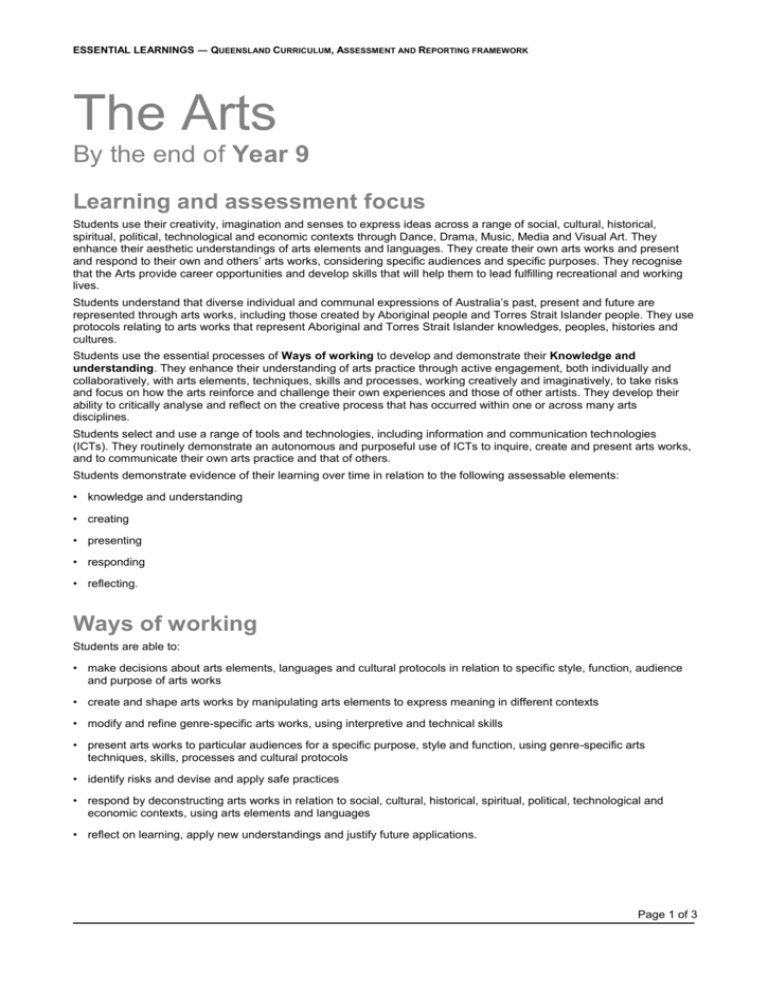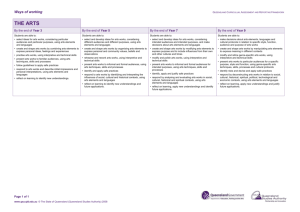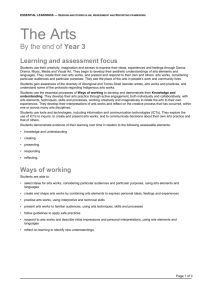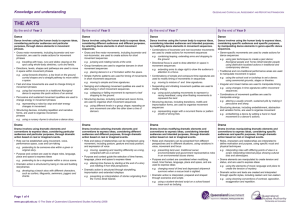The Arts - Queensland Curriculum and Assessment Authority
advertisement

ESSENTIAL LEARNINGS ― QUEENSLAND CURRICULUM, ASSESSMENT AND REPORTING FRAMEWORK The Arts By the end of Year 9 Learning and assessment focus Students use their creativity, imagination and senses to express ideas across a range of social, cultural, historical, spiritual, political, technological and economic contexts through Dance, Drama, Music, Media and Visual Art. They enhance their aesthetic understandings of arts elements and languages. They create their own arts works and present and respond to their own and others’ arts works, considering specific audiences and specific purposes. They recognise that the Arts provide career opportunities and develop skills that will help them to lead fulfilling recreational and working lives. Students understand that diverse individual and communal expressions of Australia’s past, present and future are represented through arts works, including those created by Aboriginal people and Torres Strait Islander people. They use protocols relating to arts works that represent Aboriginal and Torres Strait Islander knowledges, peoples, histories and cultures. Students use the essential processes of Ways of working to develop and demonstrate their Knowledge and understanding. They enhance their understanding of arts practice through active engagement, both individually and collaboratively, with arts elements, techniques, skills and processes, working creatively and imaginatively, to take risks and focus on how the arts reinforce and challenge their own experiences and those of other artists. They develop their ability to critically analyse and reflect on the creative process that has occurred within one or across many arts disciplines. Students select and use a range of tools and technologies, including information and communication technologies (ICTs). They routinely demonstrate an autonomous and purposeful use of ICTs to inquire, create and present arts works, and to communicate their own arts practice and that of others. Students demonstrate evidence of their learning over time in relation to the following assessable elements: • knowledge and understanding • creating • presenting • responding • reflecting. Ways of working Students are able to: • make decisions about arts elements, languages and cultural protocols in relation to specific style, function, audience and purpose of arts works • create and shape arts works by manipulating arts elements to express meaning in different contexts • modify and refine genre-specific arts works, using interpretive and technical skills • present arts works to particular audiences for a specific purpose, style and function, using genre-specific arts techniques, skills, processes and cultural protocols • identify risks and devise and apply safe practices • respond by deconstructing arts works in relation to social, cultural, historical, spiritual, political, technological and economic contexts, using arts elements and languages • reflect on learning, apply new understandings and justify future applications. Page 1 of 3 ESSENTIAL LEARNINGS ― QUEENSLAND CURRICULUM, ASSESSMENT AND REPORTING FRAMEWORK Knowledge and understanding Dance Dance involves using the human body to express ideas, considering specific audiences and specific purposes, by manipulating dance elements in genre-specific dance sequences. • Genre-specific movements are used to create actions for dance sequences e.g. using jazz techniques to create a jazz dance; Aboriginal people and Torres Strait Islander people using distinctive localised actions in traditional and contemporary dances. • Traditional and non-traditional performance areas are used to manipulate movement in space e.g. using the school oval or tuckshop to set a dance; using ceremonial grounds, stages or theatres. • Irregular and mixed metres are used to manipulate timing e.g. using changes in time signatures within movement sequences. • Combinations of movement qualities are used to manipulate energy e.g. altering a usually smooth, sustained plié by making it percussive and sharp. • Structuring devices, including embellishment, abstraction and variation forms, are used to organise movement e.g. embellishing a dance by adding a hand or head movement to a dancer’s actions. Drama Drama involves manipulating dramatic elements and conventions to express ideas, considering specific audiences and specific purposes, through dramatic action based on real or imagined events. • Roles, characters and relationships are interpreted to define motivation and purpose, using specific vocal and physical techniques e.g. interpreting roles with differing points of view in a script; interpreting historical plays showing cultural bias and stereotypes. • Drama elements are manipulated to create tension and status, and are used to express ideas e.g. using the elements of mood, language and place to create the tension of mystery. • Dramatic action and texts are created and interpreted through specific styles, including realism and non-realism e.g. using clowning conventions of contrast, opposition, exaggeration and repetition. Media Media involves constructing meaning, considering specific audiences and specific purposes, by manipulating media languages and technologies to shape representations. • Still and moving images, sounds and words are used to construct and reconstruct meaning in media texts e.g. re-editing scenes to heighten the audience’s emotions. • Media techniques and practices are used to market, promote, deliver and exhibit media texts e.g. fulfilling the responsibilities attached to various production roles; surveying friends and family to complete market research to inform the design of a video game. • Representations of different beliefs and ideas in media texts are influenced by regulations and by contexts of audiences, producers and institutions e.g. using cross-media promotion to reach varied audiences with selected media texts to deliver an anti-smoking message; Indigenous broadcasting services targeting remote Aboriginal and Torres Strait Islander communities. Page 2 of 3 ESSENTIAL LEARNINGS ― QUEENSLAND CURRICULUM, ASSESSMENT AND REPORTING FRAMEWORK Music Music involves singing, playing instruments, listening, moving, improvising and composing by manipulating the music elements to express ideas, considering specific audiences and specific purposes, through sound. • Duration, beat, time values and metre are used to create and vary rhythm e.g. using syncopation and mixed metre. • Pitch, tonalities, scales and intervals are used to create and vary the horizontal arrangement of sound e.g. using modulation in a melody. • Tonalities and harmonies are used to organise music in different vertical arrangements e.g. identifying major, minor, modal, atonal or jazz harmonies within compositions. • Contemporary, traditional and genre-specific musical forms are used to structure music e.g. using sampling and sequencing to structure music; the sonata form. • Interaction between the linear and the vertical arrangement of music is used to create the texture or density of sound e.g. hearing and identifying monophonic, homophonic or polyphonic textures. • Vocal, instrumental, electronic and computer-generated sound sources have characteristic sound qualities (tone colour) that can be altered through methods of production and manipulation e.g. using digital and electronic effects to create distortion, echo and reverberation. • Relative softness and loudness of sounds, and digital and electronic devices, are used to change dynamic levels and expression of music e.g. altering MIDI track preferences to change the volume and attack of sound. Visual Art Visual Art involves manipulating visual arts elements, concepts, processes and forms (both 2D and 3D) to express ideas, considering specific audiences and specific purposes, through images and objects. • Ideas are researched to inform visual responses that consider social and cultural issues e.g. using ideas about the history of cultural contact in Australia to inform a sculptural response promoting reconciliation. • Design and visual documentation are used to develop images and objects from visual, verbal and tactile stimuli e.g creating a folio of work that is a conscious record of personal thoughts, feelings and ideas. • Media areas are used in isolation and in combination to make arts works e.g. using animated sculptural forms in an installation. • Visual arts elements and concepts in combination are used to create compositions e.g. combining a sequence of non-representational shapes in a lino print to symbolise cultural belonging. Page 3 of 3









